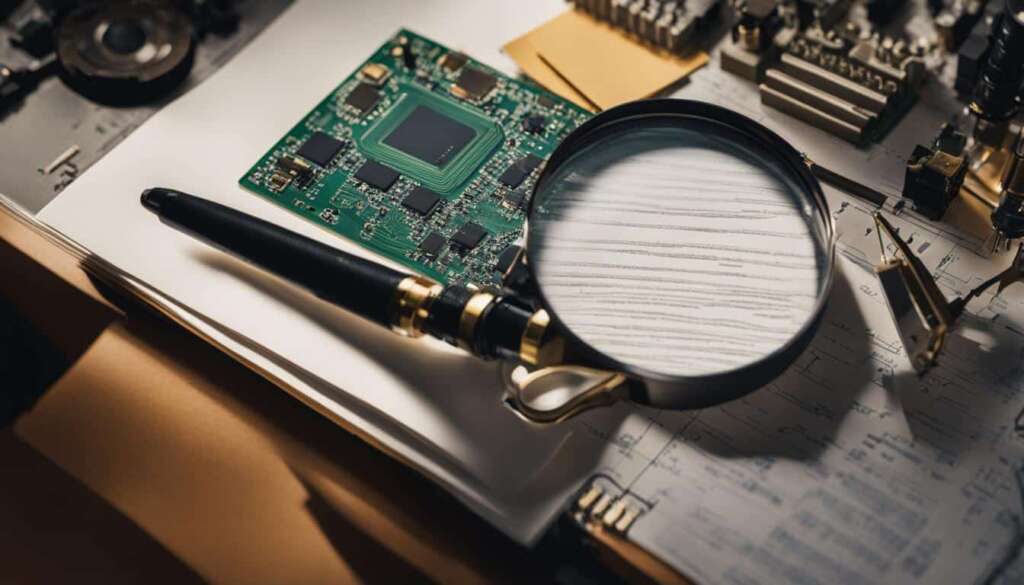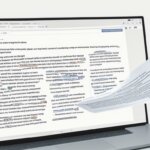Table of Contents
As the use of ChatGPT in academic settings continues to rise, universities and educators are faced with the challenge of detecting AI-generated content in students’ work. ChatGPT, with its advanced natural language processing capabilities, can produce text that closely resembles human writing, making it difficult to identify. However, several methods and tools can aid in the detection process, ensuring the integrity of educational outcomes.
One key factor in detecting the usage of ChatGPT is the concept of perplexity. Perplexity measures the complexity and coherence of written text, and AI-generated content often exhibits lower perplexity compared to human-authored work. Burstiness, which reflects the variation between sentences, can also indicate the presence of AI-generated content, as machines tend to have less variability compared to humans.
Universities employ AI detection software, such as GPTZero, to identify the use of ChatGPT in student assignments and essays. These tools analyze the text for specific language patterns and characteristics that are indicative of AI generation. Additionally, human educators play a crucial role in detecting AI-generated content, leveraging their expertise and knowledge to identify deviations from expected writing styles and patterns.
Document formatting can also assist in the detection of AI-generated content. Deviations from established formatting guidelines, such as the widely used APA format, may raise suspicion and prompt further investigation into the authenticity of the work.
OpenAI, the organization behind ChatGPT, is actively working on incorporating watermarks into ChatGPT’s responses. This additional measure aims to make it easier for educators and institutions to identify AI-generated content effectively.
Through a combination of AI detection software, human expertise, and attention to document formatting, universities can detect the usage of ChatGPT in students’ work, ensuring academic integrity and preventing the misuse of AI technology in education.
Factors Affecting ChatGPT Detectability
When it comes to detecting the usage of ChatGPT in students’ work, several key factors impact detectability. These factors include perplexity, burstiness, and the utilization of AI detection tools.
Perplexity: Measuring Complexity
Perplexity plays a significant role in determining the detectability of ChatGPT-generated text. It measures the complexity of written content and affects the ability to differentiate between human and AI-generated text. Higher perplexity values indicate more complex and potentially AI-generated content.
Burstiness: Variance in Sentences
The burstiness of text is another important factor to consider. It refers to the variation in sentence structure, with humans typically displaying more diversity in their writing compared to AI models. Detecting burstiness helps in identifying potential instances of AI-generated content.
Different Degrees of Detectability
Not all AI models have the same level of detectability. Some models, like ChatGPT, possess advanced natural language processing capabilities that enable them to produce text that closely resembles human writing. This makes it essential to consider the specific AI model being used when evaluating detectability.
Perplexity Influencers
The perplexity of AI-generated text can be influenced by various factors. Specificity, which refers to the level of detailed information provided, impacts the perplexity score. Additionally, the vocabulary used, range of topics covered, and conceptual understanding also play a role in determining perplexity and, consequently, detectability.
AI Detection Tools: Enhancing Detectability
Universities and educational institutions can enhance their ability to detect ChatGPT usage through the use of AI detection tools. These tools, such as GPT detectors and Originality AI, are designed to identify instances of ChatGPT-generated content by comparing it to known AI models and patterns.
| Factors | Effect on Detectability |
|---|---|
| Perplexity | A higher perplexity value indicates potentially AI-generated content. |
| Burstiness | Lower variance in sentence structure may suggest AI-generated text. |
| Specificity | Higher specificity can increase perplexity and detectability. |
| Vocabulary | Unusual or advanced vocabulary may point to AI-generated content. |
| Range of Topics | AI-generated content may display limited topic diversity. |
| Conceptual Understanding | AI models may struggle with complex concepts, impacting detectability. |
Can Universities Detect ChatGPT?
Universities have the ability to detect the usage of ChatGPT through various methods. One effective approach is the utilization of AI detection software, such as GPTZero and Originality AI. These software tools are specifically designed to identify AI-generated content, including ChatGPT.
In addition to AI detection software, human educators also play a significant role in detecting AI-generated content. Through their expertise and experience, educators can recognize patterns and characteristics that are indicative of AI-generated text. They can distinguish the nuances between human and machine-generated writing, enabling them to identify instances of ChatGPT usage.
Document formatting is another important aspect in the detection of AI-generated content. Universities often follow specific formatting guidelines, such as the APA format. Deviations from these standards can raise suspicion and be a telltale sign of AI-generated text. University professors and assessors are trained to spot such deviations, which can assist in the identification of ChatGPT usage.
Moreover, some professors can identify the use of ChatGPT based on the quality of responses. AI-generated text may exhibit mediocre or generic responses lacking critical analysis and in-depth understanding. This can be a red flag for educators, prompting them to investigate further and potentially detect the use of ChatGPT.
To aid in the detection process, OpenAI has plans to introduce watermarks to ChatGPT’s responses. These watermarks will serve as visible indicators, making it easier for universities and educators to identify AI-generated content.
In Summary:
- AI detection software, including GPTZero and Originality AI, enables universities to detect the use of ChatGPT.
- Human educators can rely on their expertise to identify AI-generated content.
- Document formatting, such as APA guidelines, can reveal deviations that may indicate the use of ChatGPT.
- Professorial analysis of the quality and critical analysis of responses can raise suspicion of AI-generated text.
- OpenAI plans to introduce watermarks to ChatGPT’s responses for enhanced detection.

Universities are actively working towards staying ahead in detecting the usage of AI-generated content, ensuring academic integrity and promoting honest and original work from students.
How Does Turnitin Detect ChatGPT?
Turnitin, a widely used plagiarism detection tool, employs AI technology in its algorithm to detect ChatGPT and other AI-generated text with 98% certainty. It relies on a comprehensive database that houses known AI-generated content, allowing it to compare student work and identify potential instances of plagiarism.
Turnitin’s AI-based similarity detection mechanism analyzes the submitted document and searches for similarities in the content. It considers various factors like sentence structure, vocabulary, and phrasing to flag potential instances of similarity. This advanced technology enables Turnitin to effectively identify ChatGPT usage and detect AI-generated content.
Another popular plagiarism checker, Copyscape, also has the capability to detect AI-written text. Similar to Turnitin, it compares the submitted document with a vast database of existing content to identify potential matches and instances of plagiarism.
Manual Review and Analysis by Professors
In addition to AI-powered tools, professors play a crucial role in detecting AI-generated content. Through their expertise and familiarity with students’ writing abilities, professors can manually review and analyze the submitted work for signs of AI usage. They can identify inconsistent writing styles, sudden improvements in language proficiency, or unusual patterns of similarity, which may indicate the use of AI writing tools like ChatGPT.
“Professors can leverage their experience and knowledge to identify discrepancies and anomalies that AI detection tools might overlook.”
Combining AI Detection Tools and Manual Review
The combination of AI-powered tools like Turnitin and manual review by professors creates a robust system for identifying ChatGPT usage and detecting AI-generated content. While AI detection tools provide automated and comprehensive analysis, human review adds an additional layer of scrutiny and context-based evaluation, making the detection process more accurate and reliable.
By utilizing both AI detection tools and manual review, universities can effectively identify ChatGPT usage and maintain the integrity of academic work. This proactive approach helps prevent academic dishonesty and ensures that students are assessed based on their own knowledge and abilities.
Now let’s take a look at a table summarizing the detection methods:
| Plagiarism Detection Method | Detection Capability | Advantages |
|---|---|---|
| Turnitin | 98% certainty in detecting ChatGPT and AI-generated content | AI-powered similarity detection |
| Copyscape | Detects AI-written text | Comparison with extensive database |
| Manual Review by Professors | Identifying discrepancies and anomalies | Subjective evaluation based on expertise |
Through the combination of AI detection tools and human expertise, universities can effectively detect ChatGPT and ensure the authenticity of academic work.
Pros and Cons of Using ChatGPT in Education
ChatGPT, the advanced natural language processing technology, offers various benefits in the field of education. It can enhance the learning experience by automating tasks such as grading, freeing up valuable time for educators. Furthermore, the personalized instruction provided by ChatGPT caters to the unique learning needs of individual students, promoting better academic outcomes.
Another advantage of integrating ChatGPT into classrooms is its ability to improve student engagement. With its interactive interface and conversational abilities, ChatGPT creates an immersive learning environment that captivates students’ attention and encourages active participation.
“ChatGPT’s automation and personalized instruction features contribute to a more efficient and engaging educational experience.”
Moreover, introducing technology like ChatGPT prepares students for the future of work, where artificial intelligence will play an increasingly prominent role. Familiarity with AI technologies empowers students to navigate and thrive in a digitally driven workforce.
However, it is crucial to consider the potential drawbacks of using ChatGPT in academic writing tasks. The technology’s ability to generate text that closely mimics human writing poses challenges in maintaining academic integrity. Plagiarism detection software often flags AI-generated content, compromising students’ academic standing and the credibility of educational institutions.
Teachers and students alike must exercise responsible usage of ChatGPT, ensuring it is used as a supplementary tool rather than relying on it for complete essays or assignments. Proper teacher-student communication about the risks associated with academic dishonesty can help prevent unintentional misuse of technology.
By striking a balance between leveraging technology in classrooms and upholding academic integrity, educational institutions can harness the benefits of ChatGPT while preparing students for the future.
How to Avoid Plagiarism with ChatGPT
To maintain academic integrity and ensure ethical use of AI, it is crucial to understand how to avoid plagiarism when using ChatGPT. While ChatGPT can be a helpful tool for proofreading, improving wording, and citing sources correctly, it is best to write the content yourself to prevent any risk of plagiarism.
Unlike humans, AI cannot distinguish between original writing and plagiarized content. Therefore, it is essential to rely on your own knowledge and ideas when creating academic work. While ChatGPT can assist in generating ideas and providing suggestions, it should never replace the effort and authenticity of your original work.
“Using ChatGPT as an assistive tool can enhance the writing process, but it should never be a substitute for your own creativity and critical thinking.”
By utilizing ChatGPT responsibly and ethically, you can leverage its capabilities while avoiding plagiarism. Here are some practical tips to help you maintain academic integrity while using ChatGPT:
- Use ChatGPT for language and style improvement, not for generating complete essays or assignments.
- Conduct thorough research and gather information from reliable sources before using ChatGPT.
- Develop a strong understanding of the topic and express your original thoughts and ideas.
- Properly cite and reference any sources used in your work, ensuring to follow the appropriate citation style guidelines.
- Take the time to proofread and revise your work to eliminate any unintentional similarities or inconsistencies.
By following these guidelines, you can maximize the benefits of using ChatGPT while maintaining academic honesty and avoiding plagiarism. Remember, ethical use of AI is essential in preserving the authenticity and credibility of your academic pursuits.
| Advantages of Using ChatGPT | Disadvantages of Using ChatGPT |
|---|---|
| 1. Automation of tasks like grading | 1. Increased risk of plagiarism |
| 2. Personalized instruction and feedback | 2. Compromised academic integrity |
| 3. Improved student engagement | 3. Triggering plagiarism alerts |
| 4. Preparation for the future of work | 4. Potential over-reliance on AI |
Conclusion
AI technology, such as ChatGPT, has found its way into the education sector, offering various benefits and opportunities for students and educators alike. However, it is crucial to ensure the ethical use of AI in education and be aware of its implications.
While ChatGPT provides advantages like automated grading and personalized instruction, its usage can be detected by universities and schools. This highlights the importance of using AI tools responsibly and avoiding academic dishonesty.
Teachers and students must prioritize original work and be cautious not to rely solely on AI-generated content. It is essential to foster critical thinking, analytical skills, and creativity, as these qualities cannot be replicated by AI.
As AI continues to evolve in education, it is imperative for all stakeholders to understand the ethical considerations surrounding AI use. By fostering a culture that values originality, integrity, and responsible AI use, we can harness the potential of AI to enhance education while maintaining academic rigor.
FAQ
How do teachers know if you use ChatGPT?
Teachers can detect ChatGPT usage through AI detection tools like GPTZero and Originality AI. They can also rely on their expertise and experience to identify AI-generated content.
What factors affect ChatGPT detectability?
Factors like perplexity and burstiness influence the detectability of ChatGPT. Perplexity measures the complexity of written text, while burstiness measures variability between sentences. Different AI models have different degrees of detectability.
Can universities detect ChatGPT?
Yes, universities can detect ChatGPT usage through AI detection software like GPTZero and Originality AI. They can also rely on human educators who can spot inconsistencies and deviations in document formatting. OpenAI plans to add watermarks to ChatGPT’s responses for easier detection.
How does Turnitin detect ChatGPT?
Turnitin uses AI in its algorithm for plagiarism detection. It can detect ChatGPT and other AI-generated text with 98% certainty by comparing student work to a database of known AI-generated text. It can identify similarities in text and flag potential plagiarism. Other plagiarism checkers like Copyscape can also detect AI-written text.
What are the pros and cons of using ChatGPT in education?
ChatGPT has benefits such as automating tasks like grading and providing personalized instruction. It can improve student engagement and prepare them for the future of work. However, there are concerns about using ChatGPT for academic writing tasks as it can trigger plagiarism alerts and compromise academic integrity.
How to avoid plagiarism with ChatGPT?
To avoid plagiarism, it’s best to write the content yourself. While ChatGPT can assist with proofreading, improving wording, and citing sources correctly, relying on it for whole essays or assignments can be risky. AI cannot distinguish between gathering information and plagiarizing, but humans can. Therefore, it should be used as an assistive tool rather than a replacement for original work.
What is the role of technology in education?
Technology, including AI like ChatGPT, can positively impact education by automating tasks, providing personalized instruction, and improving student engagement. However, its usage should be balanced with ethical considerations and the need to prevent academic dishonesty.
What are the ethical implications of using AI in education?
The ethical implications of AI use in education include the potential for academic dishonesty, the need to prioritize original work, and ensuring fairness in grading and assessment. Teachers and students should be aware of these implications and use AI tools responsibly.













